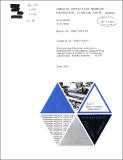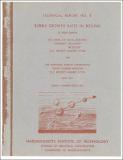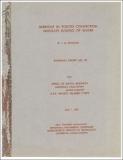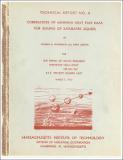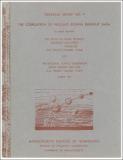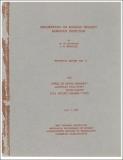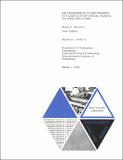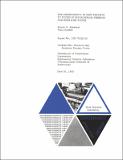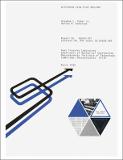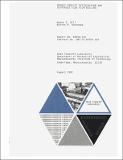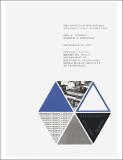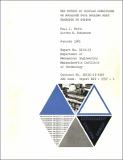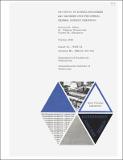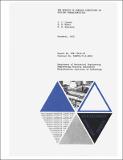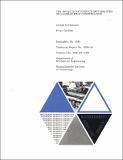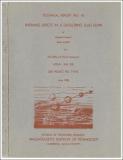Browsing Heat Transfer Laboratory Technical Reports by Title
Now showing items 1-20 of 80
-
Areas of contact and pressure distribution in bolted joints
(Cambridge, Mass. : M.I.T. Engineering Projects Laboratory, [1970], 1970)When two plates are bolted (or riveted) together these will be in contact in the immediate vicinity of the bolt heads and separated beyond it. The pressure distribution and size of the contact zone is of considerable ... -
Boiling and condensation in a liquid-filled enclosure
(Cambridge, Mass. : M.I.T. Heat Transfer Laboratory, [1971], 1971)A combined experimental and analytical investigation of boiling and condensation in a liquid-filled enclosure, with water and Freon- 113 as the working fluids, is described. The operating characteristics of a boiling system, ... -
Bubble growth rates in boiling
(Cambridge, Mass. : Massachusetts Institute of Technology, Division of Industrial Cooperation, [1956], 1956)The conditions determining the growth rate of a bubble on a surface in boiling are considered and a mathematical model framed in the light of these conditions. The growth rate is then calculated for bubbles growing under ... -
The bubbly-slug transition in a high velocity two phase flow
(Cambridge, Mass. : M.I.T. Division of Sponsored Research, [1964], 1964)A possible mechanism for the transition between bubbly and slug flow is proposed and tested in a simulated slug flow system. No sudden collapse of slug flow with increasing velocity is found and it is concluded that: a. ... -
Burnout in forced convection nucleate boiling of water
(Cambridge, Mass. : M.I.T. Heat Transfer Laboratory, [1957], 1957)Data are presented for burnout in forced coivection nucleate boiling of water at pressures above 500 psia. A dimensionless correlation is devised for. the M.I.T. data which is found to be valid for certain recent data ... -
Cooling of high-power-density computer components
(Cambridge, Mass. : M.I.T. Heat Transfer Laboratory, [1968], 1968)This report summarizes work carried out during the first two years of a research program sponsored by IBM Corporation. This study has elucidated a number of the heat-transfer characteristics of several fluorochemicals which ... -
Correlation of maximum heat flux data for boiling of saturated liquids
(Cambridge, Mass. : Massachusetts Institute of Technology, Division of Industrial Cooperation, [1955], 1955) -
The correlation of nucleate boiling burn-out data
(Cambridge, Mass. : M.I.T. Division of Industrial Cooperation, [1957], 1957)A dimensionless correlation is developed for nucleate boiling buzrnout data including the following ranges of variables. Fluids - Water Bensene n - Heptane n - Pentane Ethanol Pressure - 0.0045 to 0.96 of critical pressure ... -
Description of boiling project burnout detector
(Cambridge, Mass. : M.I.T. Heat Transfer Laboratory, [1957], 1957)Introduction: In order to effectively utilize the high heat flux available through the mechanism of nucleate boiling in forced convection heat transfer, it is of primary importance that the maximum flux or "burnout" ... -
The deterioration in heat transfer to fluids at super-critical pressure and high heat fluxes
(Cambridge, Mass. : M.I.T. Engineering Projects Laboratory, [1968], 1968)Introduction: Several supercritical steam generators in the American Electric Power system have shown evidence of tube overheat in the lower furnance at the point where the water bulk temperature is about 670 0 F. The ... -
The deterioration in heat transfer to fluids at supercritical pressure and high heat fluxes
(Cambridge, Mass. : M.I.T. Engineering Projects Laboratory, [1968], 1968)At slightly supercritical pressure and in the neighborhood of the pseudo-critical temperature (defined as the temperature corresponding to the peak in specific heat at the operating pressure), the heat transfer coefficient ... -
Dispersed flow film boiling
(Cambridge, Mass. : Heat Transfer Laboratory, Dept. of Mechanical Engineering, Massachusetts Institute of Technology, [1980], 1980)Dispersed flow consists of small liquid droplets entrained in a flowing vapor. This flow regime can occur in cryogenic equipment, in steam generators, and during nuclear reactor loss of coolant accidents. A theoretical ... -
Dryout droplet distribution and dispersed flow film boiling
(Cambridge, Mass. : Heat Transfer Laboratory, Dept. of Mechanical Engineering, Massachusetts Institute of Technology, [1982], 1982)Dispersed flow film boiling is characterized by liquid-phase droplets entrained in a continuous vapor-phase flow. In a previous work at MIT, a model of dispersed flow heat transfer was developed, called the Local Conditions ... -
The effect of nonuniform axial heat flux distribution on the critical heat flux
(Cambridge, Mass. : M.I.T. Dept. of Mechanical Engineering, [1965], 1965)A systematic experimental and analytic investigation of the effect of nonuniform axial heat flux distribution on critical heat rilux was performed with water in the quality condition. Utilizing a model which ascribes the ... -
The effect of surface conditions on nuceate pool boiling heat transfer to sodium
(Cambridge, Mass. : M.I.T. Dept. of Mechanical Engineering, [1965], 1965)A simplified theoretical model for bubble nucleation stability has been proposed, and an approximate stability criterion has been developed. This criterion contains both fluid and surfqce properties, and it predicts that ... -
The effect of surface roughness and waviness upon the overall thermal contact resistance
(Cambridge, Mass. : M.I.T. Dept. of Mechanical Engineering, [1966], 1966)A thermal contact conductance equation was developed which considers both the effect of surface roughness and waviness. It was shown that the overall thermal contact conductance is determined by the roughness at large ... -
The Effect of vapor subcooling on film condensation of metals
(Cambridge, Mass. : M.I.T. Engineering Projects Laboratory, [1968], 1968)This work presents an analysis of the interfacial "vapor-condensate" temperature distribution, which includes the effect of subcooling (supersaturation) in the vapor. Experimental data from previous investigators for ... -
The effects of surface conditions on boiling characteristics
(Cambridge, Mass. : M.I.T. Engineering Projects Laboratory, [1972], 1972)A unified model relating surface variables to the nucleate pool boiling characteristics was developed. A simple vapor trapping mechanism was postulated and a geometrical model constructed for idealized conical cavities ... -
The effects of surface instabilities on laminar film condensation
(Cambridge, Mass. : M.I.T. Dept. of Mechanical Engineering, [1965], 1965)Heat transfer rates for laminar film condensation of Freon-1l3 were measured on the underside of horizontal surfaces, inclined surfaces, and vertical surfaces. Several distinct regimes of flow were observed. On the underside ... -
Entrance effects in a developing slug flow
(Cambridge, Mass. : Massachusetts Institute of Technology, Division of Industrial Cooperation, [1960], 1960)The kinetics of a Taylor bubble, as it rises behind a series of other bubbles in a gas-liquid slug flow, have been determined. The rise velocity of a bubble is expressed as a function of separation distance from the bubble ...

